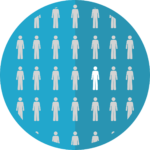 300 million people living with a rare disease worldwide
300 million people living with a rare disease worldwide
An open-access article, written by Orphanet (coordinated by INSERM, the French National Institute of Health and Medical Research), EURORDISRare Diseases Europe and Orphanet Ireland (based at the National Rare Diseases Office, Mater Misericordiae University Hospital, Dublin, Ireland), confirms the number of people living with a rare disease is estimated at 300 million worldwide. According to this paper published in the European Journal of Human Genetics, rare diseases currently affect at any point in time 3.5% – 5.9% of the worldwide population, equivalent to a conservative estimate of 300 million people worldwide (4% of the an estimated world population of 7.5 billion), the number used until now by EURORDIS and Rare Diseases International. The analysis shows that there are over 6,000 clinically defined rare diseases, 72% are genetic, and of those 70% of rare diseases start in childhood.
This is the first time that a robust analysis of the global prevalence of rare diseases has been conducted using the publicly available epidemiological data in the Orphanet (www.orpha.net) database. The figures presented in the paper are derived from data from 67.6% of the prevalent rare diseases. As this analysis does not take into account rare cancers, nor rare diseases caused by rare bacterial or viral infectious diseases and poisonings, the number of people affected by rare diseases is likely considerably higher. Ana Rath, co-author of the paper, Director of Orphanet, stated, “Even if these are the best figures we can obtain today, they likely underestimate the number of rare disease patients still not visible in healthcare and social care systems. Having a specific codification system for them in national systems will help obtain definitive figures and, more importantly, produce data needed to adapt healthcare systems”.
Yann Le Cam, co-author of the paper, Chief Executive Officer of EURORDIS and member of the Council of Rare Diseases International, commented, “Collectively rare diseases are not rare. The findings published in this paper support years of efforts from the rare disease community to advocate for the prioritisation of rare diseases as a public health priority that affects millions of people around the world, not just the few. No one can deny the significance of the global rare disease population anymore, a critical mass of people who have been the health orphans so far, with acute needs for better healthcare, access to innovative treatments and a social system that supports their right to reach their highest potential of well-being”.
Findings presented in the paper, based on the analysis of the 67.6% of the prevalent diseases, include
that:
• 149 rare diseases analysed affect around 80% of the rare disease population. These diseases are the most prevalent among the diseases, with each affecting 100 – 500 people per 1 million.
• The next most prevalent 241 rare diseases analysed affect 10 – 100 people per 1 million people.
• Collectively, these nearly 400 diseases affect at least 98% of the rare disease population with a prevalence of 10 – 500 people per 1 million people. They can be grouped by therapeutic areas and care services built around these therapeutic areas.
• The remaining diseases analysed are the less prevalent diseases as they affect less than 10 people per 1 million people.
Building on these important data, the analysis will be developed in the future to cover rare diseases caused by infectious agents, environmental factors, bacteria or viruses, poisoning and rare cancers; and to deepen the research for around 24 rare disease groupings (mirroring the grouping adopted for
the European Reference Networks), all with the aim to ultimately help inform health and social care planning for people living with a rare disease and their families and to streamline research on rare diseases. Future registry research and the implementation of rare disease codification in healthcare systems will further refine the estimates.
(Nguengang Wakap S, Lambert D M, Olry A, Rodwell C, Gueydan C, Lanneau V, Murphy D, Le Cam Y, Rath A. Estimating cumulative point prevalence of rare diseases: analysis of the Orphanet database. European Journal of Human Genetics, 2019





COMMENTS ARE OFF THIS POST